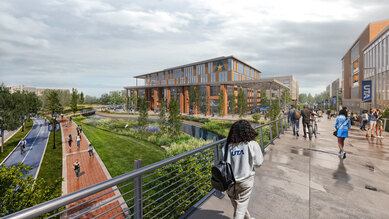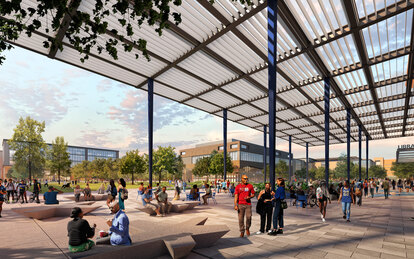University of Texas at Arlington, Campus Master Plan and Energy Transition Plan
Concurrently developing a master plan and energy transition plan allows UTA to pursue ambitious growth while reducing its environmental impact, transforming the entire campus into a living laboratory for sustainability innovation.
Client
University of Texas at Arlington
Location
Arlington, Texas
Markets/Services
Campus Planning, Campus Strategy & Analytics, Energy & Environmental Modeling, Higher Education, Sustainable Design
The University of Texas at Arlington (UTA) is the second-largest institution in the University of Texas system, an R1 public research university with more than 41,000 students. As the Dallas-Fort Worth Metroplex region experiences significant growth, UTA is planning for similar enrollment increases over the next decade. To meet the need, the university took a proactive approach to institutional planning: simultaneously accommodating burgeoning enrollment, ambitious research growth, and a responsible energy transition strategy.
UTA’s precedent-setting approach demonstrates how a university can successfully pursue both growth and carbon reduction goals. It partnered with SmithGroup to develop a comprehensive campus and energy infrastructure plan. That vision anticipates 10,000 additional students and 1,700 additional faculty and staff; accommodates doubling its annual research to $300 million; adds 2.5 million additional square feet of facilities (36 percent increase); and upgrades its campus thermal and electrical networks. By integrating these traditionally separate planning processes, UTA’s approach ensures the university's expansion ambitions and capital campaign align with its sustainability goals from the outset—enabling the campus to maintain its position as a leader in sustainable solutions and a model for institutional environmental leadership.

UTA’s Campus Master Plan prioritizes academic excellence and commitment to research through clustered, theme-based models that blur traditional boundaries and reorganize the campus to promote interdisciplinary collaboration. The plan establishes intentional intersections among nine colleges, creating spaces that emphasize adaptable research and project-based learning opportunities linking engineering, biomedical innovation, environmental science, energy, and nanofabrication. It brings together the university community to positively change global health, environmental impact, and societal transformation. The implementation framework combines traditional funding mechanisms with public-private partnerships and creative financing solutions to ensure a continued financially sustainable path forward in the near-, mid- and long-term.
UTA’s Energy Efficiency Plan complements its district-energy transformation by establishing a phased, data-driven roadmap for achieving superior energy performance across campus systems. Developed through rigorous technical analysis and stakeholder engagement, the plan integrates infrastructure modernization, high efficiency building retrofits, electrification strategies with advanced controls and distributed energy resources, as well as studying the feasibility of integrating AI and enterprise systems. It prioritizes lifecycle cost optimization and operational resilience, ensuring that each new facility meets stringent energy performance targets while legacy systems are upgraded for long-term efficiency gains. This holistic framework positions UTA as a leader in institutional energy innovation and scalable campus sustainability deployment.

The physical manifestation of the campus master plan creates an intentional cross-disciplinary ecosystem, manifested through high-performance buildings and infrastructure systems, and interconnected by expanded greenways and community open space. Together, they shape a campus that will be a living laboratory: a culture steeped in sustainability and possibility, where students and faculty engage directly with leading technologies, developing innovative solutions for today’s pressing challenges.

